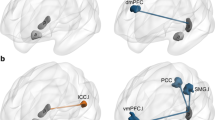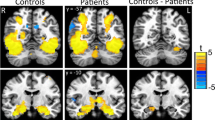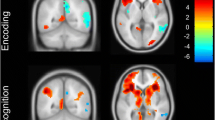Abstract
Episodic memory ability relies on hippocampal-prefrontal connectivity. However, few studies have examined relationships between memory performance and white matter (WM) microstructure in hippocampal-prefrontal pathways in schizophrenia-spectrum disorder (SSDs). Here, we investigated these relationships in individuals with first-episode psychosis (FEP) and chronic schizophrenia-spectrum disorders (SSDs) using tractography analysis designed to interrogate the microstructure of WM tracts in the hippocampal-prefrontal pathway. Measures of WM microstructure (fractional anisotropy [FA], radial diffusivity [RD], and axial diffusivity [AD]) were obtained for 47 individuals with chronic SSDs, 28 FEP individuals, 52 older healthy controls, and 27 younger healthy controls. Tractography analysis was performed between the hippocampus and three targets involved in hippocampal–prefrontal connectivity (thalamus, amygdala, nucleus accumbens). Measures of WM microstructure were then examined in relation to episodic memory performance separately across each group. Both those with FEP and chronic SSDs demonstrated impaired episodic memory performance. However, abnormal WM microstructure was only observed in individuals with chronic SSDs. Abnormal WM microstructure in the hippocampal-thalamic pathway in the right hemisphere was associated with poorer memory performance in individuals with chronic SSDs. These findings suggest that disruptions in WM microstructure in the hippocampal–prefrontal pathway may contribute to memory impairments in individuals with chronic SSDs but not FEP.




Similar content being viewed by others
References
Aas M, Dazzan P, Mondelli V et al (2014) A systematic review of cognitive function in first-episode psychosis, including a discussion on childhood trauma, stress, and inflammation. Front Psychiatry 4:1–13. https://doi.org/10.3389/fpsyt.2013.00182
Aggleton JP, O’Mara SM, Vann SD et al (2010) Hippocampal-anterior thalamic pathways for memory: uncovering a network of direct and indirect actions. Eur J Neurosci 31:2292–2307. https://doi.org/10.1111/j.1460-9568.2010.07251.x
Aleman A, Hijman R, De Haan EHF et al (1999) Memory impairment in schizophrenia: a meta-analysis. Am J Psychiatry 156(9):1358–1366. https://doi.org/10.1176/ajp.156.9.1358
American Psychiatric Association (1994) Diagnostic and statistical manual of mental disorders, 4th edn. American Psychiatric Association, Washington
Andreasen NC (1983) Scale for the assessment of negative symptoms. University of Iowa, Iowa City
Arfanakis K, Wilson RS, Barth CM et al (2016) Cognitive activity, cognitive function, and brain diffusion characteristics in old age. Brain Imaging Behav 10(2):455–463. https://doi.org/10.1007/s11682-015-9405-5.Cognitive
Barnett JH, Sahakian BJ, Werners U et al (2005) Visuospatial learning and executive function are independently impaired in first-episode psychosis. Psychol Med 35:1031–1041
Behrens TEJ, Woolrich MW, Jenkinson M et al (2003) Characterization and propagation of uncertainty in diffusion-weighted MR imaging. Magn Reson Med 50:1077–1088
Behrens TEJ, Berg HJ, Jbabdi S et al (2007) Probabilistic diffusion tractography with multiple fibre orientations: what can we gain? Neuroimage 34:144–155
Benetti S, Mechelli A, Picchioni M et al (2009) Functional integration between the posterior hippocampus and prefrontal cortex is impaired in both first episode schizophrenia and the at risk mental state. Brain 132:2426–2436. https://doi.org/10.1093/brain/awp098
Bora E, Yucel M, Pantelis C (2009) Cognitive functioning in schizophrenia, schizoaffective disorder and affective psychoses: meta-analytic study. Br J Psychiatry 195:475–482
Borgwardt S, Smieskova R, Fusar-Poli P (2012) Gray matter pathology of hippocampus—a specific endophenotype for schizophrenia? Psychiatry Res Neuroimaging. https://doi.org/10.1016/j.pscychresns.2011.12.005
Bozikas VPP, Andreou C (2011) Longitudinal studies of cognition in first episode psychosis: a systematic review of the literature. Aust N Z J Psychiatry 45(2):93–108. https://doi.org/10.3109/00048674.2010.541418
Bubb EJ, Kinnavane L, Aggleton JP (2017) Hippocampal–diencephalic–cingulate networks for memory and emotion: an anatomical guide. Brain Neurosci Adv. https://doi.org/10.1177/2398212817723443
Budde MD, Xie M, Cross AH et al (2009) Axial diffusivity is the primary correlate of axonal injury in the experimental autoimmune encephalomyelitis spinal cord: a quantitative pixelwise analysis. J Neurosci 29(9):2805–2813. https://doi.org/10.1523/JNEUROSCI.4605-08.2009
Burgess N, Maguire EA, O’Keefe J (2002) The human hippocampus and spatial and episodic memory. Neuron 35:625–641. https://doi.org/10.1016/S0896-6273(02)00830-9
Cambridge Cognition (2016) CANTAB [Cognitive assessment software]. www.cantab.com. Accessed 7 Oct 2016
Chakravarty MM, Steadman P, van Eede MC et al (2013) Performing label-fusion-based segmentation using multiple automatically generated templates. Hum Brain Mapp 34(10):2635–2654. https://doi.org/10.1002/hbm.22092
Cropley VL, Klauser P, Lenroot RK et al (2017) Accelerated gray and white matter deterioration with age in schizophrenia. Am J Psychiatry 174(3):286–295. https://doi.org/10.1176/appi.ajp.2016.16050610
Della Nave R, Ginestroni A, Diciotti S et al (2011) Axial diffusivity is increased in the degenerating superior cerebellar peduncles of Friedreich’s ataxia. Neuroradiology 53(5):367–372. https://doi.org/10.1007/s00234-010-0807-1
Di Biase MA, Cropley VL, Baune BT et al (2017) White matter connectivity disruptions in early and chronic schizophrenia. Psychol Med 47(16):2797–2810. https://doi.org/10.1017/S0033291717001313
Dolleman-ven der Weel MJ, Griffin AL, Ito HT et al (2019) The nucleus reuniens of the thalamus sits at the nexus of a hippocampus and medial prefrontal cortex circuit enabling memory and behavior. Learn Mem 26:191–205. https://doi.org/10.1101/lm.048389.118.Freely
Douet V, Chang L (2015) Fornix as an imaging marker for episodic memory deficits in healthy aging and in various neurological disorders. Front Aging Neurosci 7:1–19. https://doi.org/10.3389/fnagi.2014.00343
Douet V, Chang L, Pritchett A et al (2014) Schizophrenia-risk variant rs6994992 in the neuregulin-1 gene on brain developmental trajectories in typically developing children. Transl Psychiatry. https://doi.org/10.1038/tp.2014.41
Eichenbaum H (2017) Prefrontal–hippocampal interactions in episodic memory. Nat Rev Neurosci 18(9):547–558. https://doi.org/10.1038/nrn.2017.74
Eyler Zorrilla LT, Jeste DV, Paulus M et al (2003) Functional abnormalities of medial temporal cortex during novel picture learning among patients with chronic schizophrenia. Schizophr Res 59(2–3):187–198. https://doi.org/10.1016/S0920-9964(01)00340-1
Fett AKJ, Velthorst E, Reichenberg A et al (2020) Long-term changes in cognitive functioning in individuals with psychotic disorders: findings from the suffolk county mental health project. JAMA Psychiat 77(4):387–396. https://doi.org/10.1001/jamapsychiatry.2019.3993
Fields RD (2015) A new mechanism of nervous system plasticity: activity-dependent myelination. Nat Rev Neurosci 16:756–767. https://doi.org/10.1038/nrn4023
Fields RD, Bukalo O (2020) Myelin makes memories. Nat Neurosci 23:469–470. https://doi.org/10.1038/s41593-020-0606-x
First M, Spitzer R, Gibbon M et al (2002) Structured clinical interview for DSM-IV-TR axis I disorders, research version patient. New York State Psychiatric Institute, New York
Glahn DC, Ragland JD, Abramoff A et al (2005) Beyond hypofrontality: a quantitative meta-analysis of functional neuroimaging studies of working memory in schizophrenia. Hum Brain Mapp 25(1):60–69. https://doi.org/10.1002/hbm.20138
Godsil BP, Kiss JP, Spedding M et al (2013) The hippocampal-prefrontal pathway: the weak link in psychiatric disorders? Eur Neuropsychopharmacol 23:1165–1181
Goldberg TE, Weinberger DR (1996) Effects of neuroleptic medications on the cognition of patients with schizophrenia: a review of recent studies. J Clin Psychiatry 57(Supp. 9):62–65
Goldman HH, Skodol A, Lave TR (1992) Revising axis V for DSM-IV: a review of measures of social functioning. Am J Psychiatry 149:1148–1156
Green AE, Croft RJ, Maller JJ et al (2016) White matter correlates of episodic memory encoding and retrieval in schizophrenia. Psychiatry Res Neuroimaging 254:188–198. https://doi.org/10.1016/j.pscychresns.2016.07.002
Green MF, Kern RS, Braff DL et al (2000) Neurocognitive deficits and functional outcome in schizophrenia: are we measuring the ‘right stuff’? Schizophr Bull 26(1):119–136. https://doi.org/10.1093/oxfordjournals.schbul.a033430
Gur REC, Turetsky BI, Cowell PE et al (2000) Temporolimbic volume reductions in schizophrenia. Arch Gen Psychiatry 57(8):769–775. https://doi.org/10.1001/archpsyc.57.8.769
Habib R, Nyberg L, Tulving E (2003) Hemispheric asymmetries of memory: the HERA model revisited. Trends Cogn Sci 7(6):241–245. https://doi.org/10.1016/S1364-6613(03)00110-4
Haijma SV, Van Haren N, Cahn W et al (2013) Brain volumes in schizophrenia: a meta-analysis in over 18 000 subjects. Schizophr Bull 39(5):1129–1138. https://doi.org/10.1093/schbul/sbs118
Hasan A, Wobrock T, Falkai P et al (2011) Hippocampal integrity and neurocognition in first-episode schizophrenia: a multidimensional study. World J Biol Psychiatry 15:1–12. https://doi.org/10.3109/15622975.2011.620002
Heckers S, Rauch SL, Goff D et al (1998) Impaired recruitment of the hippocampus during conscious recollection in schizophrenia. Nat Neurosci 1(4):318–323. https://doi.org/10.1038/1137
Heinrichs RW, Zakzanis KK (1998) Neurocognitive deficit in schizophrenia: a quantitative review of the evidence. Neuropsychology 12(3):426–445. https://doi.org/10.1037/0894-4105.12.3.426
Jenkinson M, Beckmann CF, Behrens TE, Woolrich MW, Smith SM (2012) FSL. Neuroimage 62(2):782–90. https://doi.org/10.1016/j.neuroimage.2011.09.015
Jin J, Maren S (2015) Prefrontal-hippocampal interactions in memory and emotion. Front Syst Neurosci 9:1–8. https://doi.org/10.3389/fnsys.2015.00170
Juola P, Miettunen J, Salo H et al (2015) Neurocognition as a predictor of outcome in schizophrenia in the Northern Finland Birth Cohort 1966. Schizophr Res Cogn 2(3):113–119. https://doi.org/10.1016/j.scog.2015.07.001
Kalmady SV, Shivakumar V, Arasappa R et al (2017) Clinical correlates of hippocampus volume and shape in antipsychotic-naïve schizophrenia. Psychiatry Res Neuroimaging 263:93–102. https://doi.org/10.1016/j.pscychresns.2017.03.014
Kay S, Fiszbein A, Opler L (1987) The positive and negative syndrome scale (PANSS) for schizophrenia. Schizophr Bull 13(2):261–267
Kelly S, Jahanshad N, Zalesky A et al (2017) Widespread white matter microstructural differences in schizophrenia across 4322 individuals: results from the ENIGMA Schizophrenia DTI Working Group. Mol Psychiatry. https://doi.org/10.1038/mp.2017.170
Knierim JJ (2015) The hippocampus. Curr Biol 25(23):R1116–R1121. https://doi.org/10.1016/j.cub.2015.10.049
Knöchel C, Stäblein M, Storchak H et al (2014) Multimodal assessments of the hippocampal formation in schizophrenia and bipolar disorder: evidences from neurobehavioral measures and functional and structural MRI. NeuroImage Clin 6:134–144. https://doi.org/10.1016/j.nicl.2014.08.015
Kubicki M, Westin CF, Maier SE et al (2002) Uncinate fasciculus findings in schizophrenia: a magnetic resonance diffusion tensor imaging study. Am J Psychiatry 159(5):813–820. https://doi.org/10.1176/appi.ajp.159.5.813
Lancaster MA, Seidenberg M, Smith JC et al (2016) Diffusion tensor imaging predictors of episodic memory decline in healthy elders at genetic risk for Alzheimer’s disease. J Int Neuropsychol Soc 22:1005–1015. https://doi.org/10.1017/S1355617716000904
Lappin JM, Morgan C, Chalavi S et al (2013) Bilateral hippocampal increase following firstepisode psychosis is associated with good clinical, functional and cognitive outcomes. Psychol Med. https://doi.org/10.1017/S0033291713001712
Ledoux AA, Phillips JL, Labelle A et al (2013) Decreased fMRI activity in the hippocampus of patients with schizophrenia compared to healthy control participants, tested on a wayfinding task in a virtual town. Psychiatry Res Neuroimaging 211(1):47–56. https://doi.org/10.1016/j.pscychresns.2012.10.005
Lee SH, Kubicki M, Asami T et al (2013) Extensive white matter abnormalities in patients with first-episode schizophrenia: a diffusion tensor imaging (DTI) study. Schizophr Res 143:231–238. https://doi.org/10.1016/j.schres.2012.11.029
Leucht S, Rothe P, Davis JM et al (2013) Equipercentile linking of the BPRS and the PANSS. Eur Neuropsychopharmacol 23:956–959. https://doi.org/10.1016/j.euroneuro.2012.11.004
Lieberman JA, Girgis RR, Brucato G et al (2018) Hippocampal dysfunction in the pathophysiology of schizophrenia : a selective review and hypothesis for early detection and intervention. Mol Psychiatry 5:1764–1772. https://doi.org/10.1038/mp.2017.249
Liu X, Lai Y, Wang X et al (2013) Reduced white matter integrity and cognitive deficit in never-medicated chronic schizophrenia: a diffusion tensor study using TBSS. Behav Brain Res 252:157–163. https://doi.org/10.1016/j.bbr.2013.05.061
Mayo CD, Garcia-Barrera MA, Mazerolle EL et al (2019) Relationship between DTI metrics and cognitive function in Alzheimer’s disease. Front Aging Neurosci. https://doi.org/10.3389/fnagi.2018.00436
Metzler-Baddeley C, Jones DK, Belaroussi B et al (2011) Frontotemporal connections in episodic memory and aging: a diffusion MRI tractography study. J Neurosci 31(37):13236–13245. https://doi.org/10.1523/JNEUROSCI.2317-11.2011
Meyer-Lindenberg A, Poline J-B, Kohn PD et al (2001) Evidence for abnormal cortical functional connectivity during working memory in schizophrenia. Am J Psychiatry 158(11):1809–1817. https://doi.org/10.1176/appi.ajp.158.11.1809
Meyer-lindenberg AS, Olsen RK, Kohn PD et al (2005) Regionally specific disturbance of dorsolateral prefrontal-hippocampal functional connectivity in schizophrenia. Arch Gen Psychiatry 62:379–386
Mielke MM, Okonkwo OC, Oishi K et al (2012) Fornix integrity and hippocampal volume predict memory decline and progression to Alzheimer’s disease. Alzheimer’s Dement 8(2):105–113. https://doi.org/10.1016/j.jalz.2011.05.2416
Naya Y (2016) Declarative associative memory. In: Pfaff DW, Volkow ND (eds) Neuroscience in the 21st century. Springer, New York, pp 1–27. https://doi.org/10.1007/978-1-4614-6434-1_162-1
Nestor PG, Kubicki M, Kuroki N et al (2007) Episodic memory and neuroimaging of hippocampus and fornix in chronic schizophrenia. Psychiatry Res Neuroimaging 155:21–28. https://doi.org/10.1016/j.pscychresns.2006.12.020
Newcombe V, Chatfield D, Outtrim J et al (2011) Mapping traumatic axonal injury using diffusion tensor imaging: correlations with functional outcome. PLoS ONE 6(5):e19214-19214. https://doi.org/10.1371/journal.pone.0019214
Nguyen TT, Eyler LT, Jeste DV (2018) Systemic biomarkers of accelerated aging in schizophrenia: a critical review and future directions. Schizophr Bull 44(2):398–408. https://doi.org/10.1093/schbul/sbx069
Nuechterlein KH, Subotnik KL, Green MF et al (2011) Neurocognitive predictors of work outcome in recent-onset schizophrenia. Schizophr Bull 37(SUPPL. 2):33–40. https://doi.org/10.1093/schbul/sbr084
Overall J, Gorham D (1962) The Brief Psychiatric Rating Scale. Psychol Rep 10:799–812
Pan S, Mayoral SR, Choi HS et al (2020) Preservation of a remote fear memory requires new myelin formation. Nat Neurosci 23:487–499. https://doi.org/10.1038/s41593-019-0582-1
Parent MA, Wang L, Su J et al (2010) Identification of the hippocampal input to medial prefrontal cortex in vitro. Cereb Cortex 20(2):393–403. https://doi.org/10.1093/cercor/bhp108
Pergola G, Suchan B (2013) Associative learning beyond the medial temporal lobe: many actors on the memory stage. Front Behav Neurosci 7(November):162. https://doi.org/10.3389/fnbeh.2013.00162
Pipitone J, Park MTM, Winterburn J et al (2014) Multi-atlas segmentation of the whole hippocampus and subfields using multiple automatically generated templates. Neuroimage 101:494–512. https://doi.org/10.1016/j.neuroimage.2014.04.054
Preston AR, Eichenbaum H (2013) Interplay of hippocampus and prefrontal cortex in memory. Curr Biol 23(17):R764–R773. https://doi.org/10.1016/j.cub.2013.05.041
Prouteau A, Verdoux H, Briand C et al (2005) Cognitive predictors of psychosocial functioning outcome in schizophrenia: a follow-up study of subjects participating in a rehabilitation program. Schizophr Res 77:343–353. https://doi.org/10.1016/j.schres.2005.03.001
Ragland JD, Ph D, Gur RC et al (2004) Event-related fMRI of frontotemporal activity during word encoding and recognition in schizophrenia. Am J Psychiatry 161:1004–1015
Ragland JD, Ranganath C, Phillips J et al (2015) Cognitive control of episodic memory in schizophrenia: differential role of dorsolateral and ventrolateral prefrontal cortex. Front Hum Neurosci 9:1–10. https://doi.org/10.3389/fnhum.2015.00604
Rasetti R, Sambataro F, Chen Q et al (2011) Altered cortical network dynamics: a potential intermediate phenotype for schizophrenia and association with ZNF804A. Arch Gen Psychiatry 68(12):1207–1217. https://doi.org/10.1001/archgenpsychiatry.2011.103
Ringman JM, O’Neill J, Geschwind D et al (2007) Diffusion tensor imaging in preclinical and presymptomatic carriers of familial Alzheimer’s disease mutations. Brain 130(7):1767–1776. https://doi.org/10.1093/brain/awm102
Rodríguez-Sánchez JM, Ayesa-Arriola R, Pérez-Iglesias R et al (2013) Course of cognitive deficits in first episode of non-affective psychosis: a 3-year follow-up study. Schizophr Res 150:121–128. https://doi.org/10.1016/j.schres.2013.06.042
Rudebeck SR, Scholz J, Millington R et al (2009) Fornix microstructure correlates with recollection but not familiarity memory. J Neurosci 29(47):14987–14992. https://doi.org/10.1523/JNEUROSCI.4707-09.2009
Rushe TM, Woodruff PWR, Murray RM et al (1999) Episodic memory and learning in patients with chronic schizophrenia. Schizophr Res 35(1):85–96. https://doi.org/10.1016/S0920-9964(98)00117-0
Schneider M, Walter H, Moessnang C et al (2017) Altered DLPFC-hippocampus connectivity during working memory: independent replication and disorder specificity of a putative genetic risk phenotype for schizophrenia. Schizophr Bull 43(5):1114–1122. https://doi.org/10.1093/schbul/sbx001
Sheehan DV, Lecrubier MD, Sheehan KH et al (1998) The Mini-International Neuropsychiatric Interview (M.I.N.I.): the development and validation of a structured diagnostic psychiatric interview for DSM-IV and ICD-10. J Clin Psychiatry 59(20):22–33
Sigurdsson T, Duvarci S (2016) Hippocampal-prefrontal interactions in cognition, behavior and psychiatric disease. Front Syst Neurosci 9:1–18. https://doi.org/10.3389/fnsys.2015.00190
Simons JS, Spiers HJ (2003) Prefrontal and medial temporal lobe interactions in long-term memory. Nat Rev Neurosci 4:637–648. https://doi.org/10.1038/nrn1178
Smith DM, Mizumori SJY (2006) Hippocampal place cells, context, and episodic memory. Hippocampus 16:716–729. https://doi.org/10.1002/hipo
Song SK, Sun SW, Ju WK et al (2003) Diffusion tensor imaging detects and differentiates axon and myelin degeneration in mouse optic nerve after retinal ischemia. Neuroimage 20(3):1714–1722. https://doi.org/10.1016/j.neuroimage.2003.07.005
Sota TL, Heinrichs RW (2004) Demographic, clinical, and neurocognitive predictors of quality of life in schizophrenia patients receiving conventional neuroleptics. Compr Psychiatry 45(5):415–421. https://doi.org/10.1016/j.comppsych.2004.06.010
Steadman PE, Xia F, Ahmed M et al (2020) Disruption of oligodendrogenesis impairs memory consolidation in adult mice. Neuron 105(1):150-164.e6. https://doi.org/10.1016/j.neuron.2019.10.013
Takei K, Yamasue H, Abe O et al (2008) Disrupted integrity of the fornix is associated with impaired memory organization in schizophrenia. Schizophr Res 103:52–61. https://doi.org/10.1016/j.schres.2008.03.008
Tamminga CA, Stan AD, Wagner AD (2010) The hippocampal formation in schizophrenia. Am J Psychiatry 167(10):1178–1193. https://doi.org/10.1176/appi.ajp.2010.09081187
Tregellas JR, Smucny J, Harris JG et al (2014) Intrinsic hippocampal activity as a biomarker for cognition and symptoms in schizophrenia. Am J Psychiatry 171(5):549–556. https://doi.org/10.1055/s-0034-1399347
Tulving E (2002) Episodic memory: from mind to brain. Annu Rev Psychol 53:1–25
Valli I, Tognin S, Fusar-Poli P et al (2012) Episodic memory dysfunction in individuals at high-risk of psychosis: a systematic review of neuropsychological and neurofunctional studies. Curr Pharm Des 18:443–458. https://doi.org/10.2174/138161212799316271
Vargha-khadem F, Gadian DG, Watkins KE et al (1997) Differential effects of early hippocampal pathology on episodic and semantic memory. Science 277:376–380
Velligan DI, Bow-Thomas CC, Mahurin RK et al (2000) Do specific neurocognitive deficits predict specific domains of community function in schizophrenia? J Nerv Ment Dis 188(8):518–524. https://doi.org/10.1097/00005053-200008000-00007
Wannan CMJ, Bartholomeusz CF, Cropley VL et al (2018) Deterioration of visuospatial associative memory following a first psychotic episode: a long-term follow-up study. Psychol Med 48(1):132–141. https://doi.org/10.1017/s003329171700157x
Cassandra MJW, Cropley VL, Chakravarty MM et al (2018) Hippocampal subfields and visuospatial associative memory across stages of schizophrenia-spectrum disorder. Psychol Med 49(14):2452–2462. https://doi.org/10.1017/s0033291718003458
Wechsler D (1997) Wechsler Adult Intelligence Scale, 3rd edn. The Psychological Corporation, San Antonio
Wechsler D (2001) Wechsler Test of Adult Reading (WTAR). The Psychological Corporation, San Antonio
Weiss AP, Schacter DL, Goff DC et al (2003) Impaired hippocampal recruitment during normal modulation of memory performance in schizophrenia. Biol Psychiatry 53(1):48–55. https://doi.org/10.1016/S0006-3223(02)01541-X
Wolff M, Vann SD (2019) The cognitive thalamus as a gateway to mental representations. J Neurosci 39(1):3–14. https://doi.org/10.1523/JNEUROSCI.0479-18.2018
Zahr NM, Rohlfing T, Pfefferbaum A et al (2009) Problem solving, working memory, and motor correlates of association and commissural fiber bundles in normal aging: a quantitative fiber tracking study. Neuroimage 44(3):1050–1062. https://doi.org/10.1016/j.neuroimage.2008.09.046
Zanelli J, Mollon J, Sandin S et al (2019) Cognitive change in schizophrenia and other psychoses in the decade following the first episode. Am J Psychiatry 176(10):811–819. https://doi.org/10.1176/appi.ajp.2019.18091088
Zhou Y, Shu N, Liu Y et al (2008) Altered resting-state functional connectivity and anatomical connectivity of hippocampus in schizophrenia. Schizophr Res 100(1–3):120–132. https://doi.org/10.1016/j.schres.2007.11.039
Zhuang L, Sachdev PS, Trollor JN et al (2013) Microstructural white matter changes, not hippocampal atrophy, detect early amnestic mild cognitive impairment. PLoS ONE 8(3):1–10. https://doi.org/10.1371/journal.pone.0058887
Zierhut K, Bogerts B, Schott B et al (2010) The role of hippocampus dysfunction in deficient memory encoding and positive symptoms in schizophrenia. Psychiatry Res Neuroimaging 183(3):187–194. https://doi.org/10.1016/j.pscychresns.2010.03.007
Zierhut KC, Graßmann R, Kaufmann J et al (2013) Hippocampal CA1 deformity is related to symptom severity and antipsychotic dosage in schizophrenia. Brain 136(3):804–814. https://doi.org/10.1093/brain/aws335
Zola-Morgan S, Squire LR (1993) Neuroanatomy of memory. Annu Rev Neurosci 16(1):547–563. https://doi.org/10.1146/annurev.ne.16.030193.002555
Acknowledgements
This study was funded by National Health and Medical Research Council (Grant numbers 1105825, 1150083 and 1177370) and Brain and Behavior Research Foundation (Grant number 21660).
Author information
Authors and Affiliations
Corresponding author
Ethics declarations
Conflict of interest
The authors declare that they have no conflict of interest statement.
Supplementary Information
Below is the link to the electronic supplementary material.
Rights and permissions
About this article
Cite this article
Wannan, C.M.J., Bartholomeusz, C.F., Pantelis, C. et al. Disruptions in white matter microstructure associated with impaired visual associative memory in schizophrenia-spectrum illness. Eur Arch Psychiatry Clin Neurosci 272, 971–983 (2022). https://doi.org/10.1007/s00406-021-01333-0
Received:
Accepted:
Published:
Issue Date:
DOI: https://doi.org/10.1007/s00406-021-01333-0




